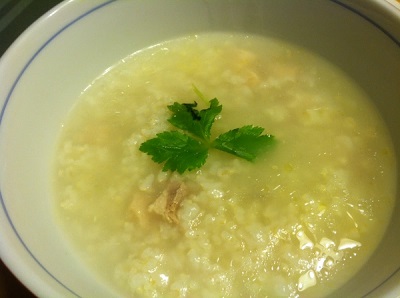Culinary Rhapsodies: Torigayu
14 Jan 2013

It was quite cold today so I was in the mood for some warm 鳥がゆ (torigayu). I was browsing through my mom’s recipe book using a pressure cooker. It was published in 1983 by a pressure cooker company フジマル (Fujimaru) and the recipe book is called, 圧力鍋のおかず Atsuryokunabe no Okazu. I’ve added a bit of my own twist by using not just regular water but homemade chicken stock. The recipe requires the use of thinly sliced chicken breast but I recommend purchasing chicken breast with bone. This is to cut the meat off the bones and use the remainder of the meat and bones for chicken stock. If you desire not to do that, then I would recommend getting the thinly sliced chicken breast and forego the stock completely. I do not recommend using bouillon cubes or store bought chicken stock. It’s too salty and it does not enhance this dish but rather would kill the subtle flavors. The ginger juice is the same as the gyoza recipe step 2. You cut/peel the brown skin off, grate/grind the ginger, squeeze it between your fingers and only use the liquid from the ginger. This recipe requires 2 teaspoons which is about one large ginger. My husband uses the ginger that I have left over by pouring hot water over it and having some ginger water. He sometimes adds lemon into it. It’s quite spicy so be sure not to use too much!
Serves 8
Ingredients:
- 2 cups of rice
- 20 cups of water
- 400 g of chicken
- 2 tablespoon of sake
- 2 teaspoon of ginger juice
- 2 teaspoon of salt
- mitsuba for decoration
Directions:
- Rinse the rice. Place the rice in the pressure cooker and add 15 cups of water. In a medium size pot, measure and fill with 5 cups of water. (If you don’t want to make your own chicken stock, then fill the pressure cooker with 20 cups of water and skip to direction 3).

- Cut the chicken off of the bone. It’s all right that there’s some meat left on the bone. Heat the pot on high and once it reaches to a boil, lower to a low to medium setting. Place the chicken bones into the pot and cover. Let it simmer for 20 – 30 minutes. Take the bones out and measure 5 cups. If the water has evaporated and you’re short 5 cups, make sure you add water to equal 5. Then place that into the pressure cooker.
- Cut the chicken into pieces that are 5 mm.
 They should be tiny bits and not large chunks. Place the chicken in a bowl and mix it with sake and ginger juice. Place that into the pressure cooker.
They should be tiny bits and not large chunks. Place the chicken in a bowl and mix it with sake and ginger juice. Place that into the pressure cooker. - Heat the pressure cooker on high. When the steam starts escaping and it makes a “shhhhhhh” sound, place it on low heat for 20 minutes. Turn the heat off at 20 minutes and dunk the entire pot in cold water. I don’t have anything large enough to fit my pressure cooker, so I placed a stopper in my kitchen sink and filled it with cold water and placed the pressure cooker in it. This is to help lower the pressure that’s built up in the cooker. Once the pressure has lowered, open it and add salt.
- Scoop out into a bowl with a ladle, add some mitsuba and it’s ready to eat!
We ate this with some chicken that had been marinated, which was a perfect pairing of fried, crunchy saltiness with the subtle flavors of the torigayu. Enjoy!